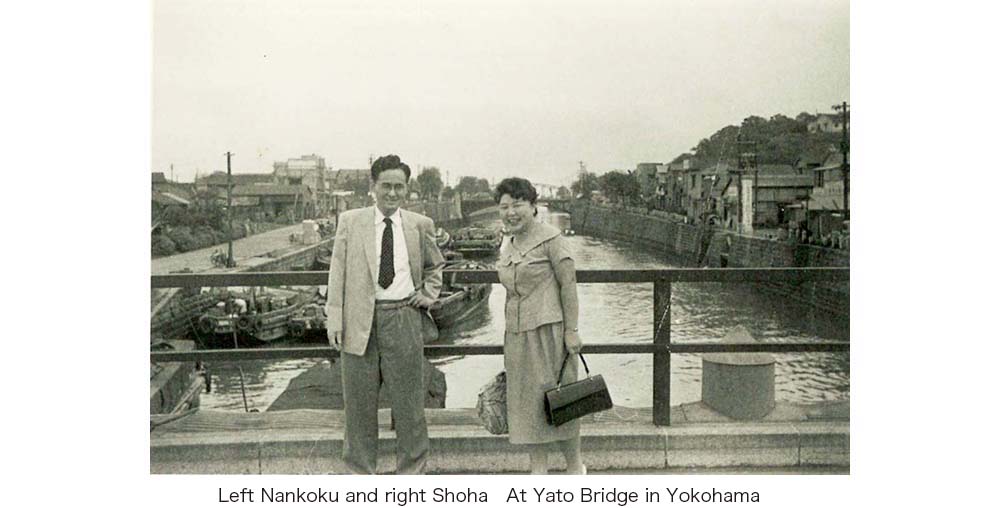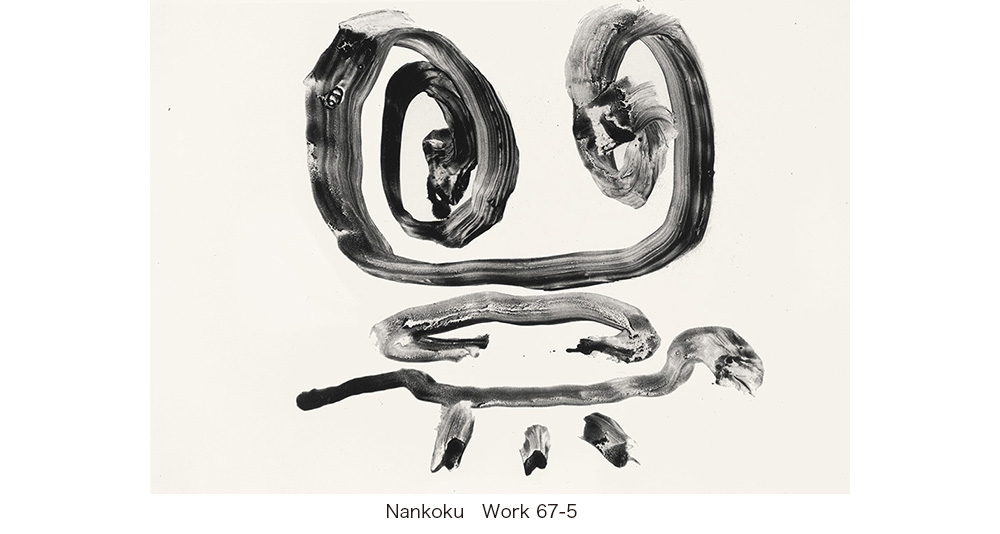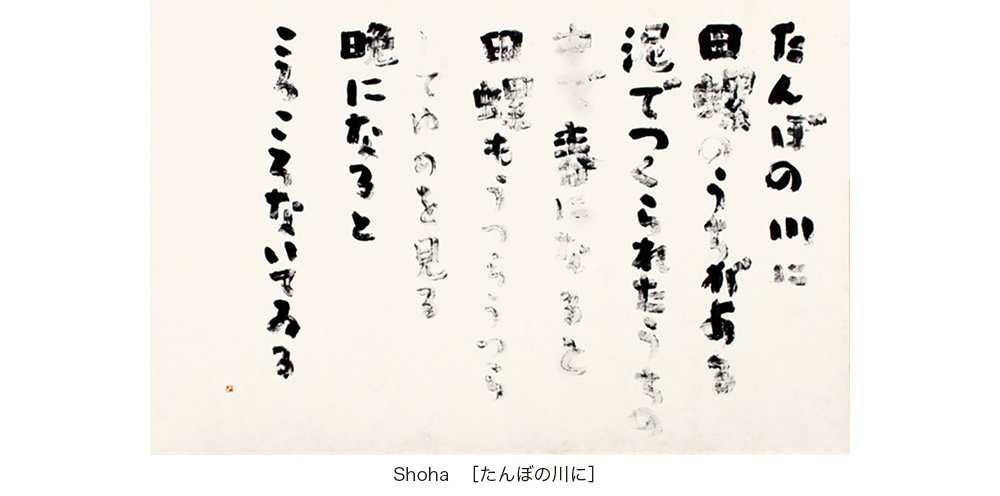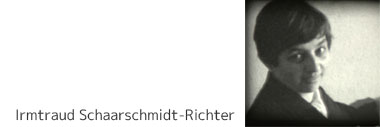
Nankoku Hidai and Shoha Hidai were well-known as a happily married couple in the world of calligraphy. They worked together as calligraphers and served as judge’s members of the Mainichi Calligraphy Exhibition, including other calligraphy exhibitions. They had the zeal and the inquiring minds to calligraphy in common, though their expressions were different from each other as Nankoku worked in the sphere of the avant-garde calligraphy and Shoha in the sphere of the mixed Kanji- Kana calligraphy. They both exchanged the criticism of each other’s work.
Yasuko Hidai was born in 1914 as the eldest daughter of Mariko and Giichi Yamamasu. After her father Giichi had worked as a captain of the outward-bound ship, he was active as a pilot in Yokohama Port and was a prominent figure of the shipping industry in Yokohama. While studying at the national Tokyo Shosen Gakko (the Tokyo Higher Merchant Shipping School), Giichi read “THE BIBLICAL STUDY”, the first biblical journal in Japan published by Kanzo Uchimura, and he was deeply moved to be a devout Christian. Then Mariko and Giichi became Kanzo Uchimura’s pupils and served as the central organizers of Kanzo's Bible Study Lectures at Tsunohazu and at Imai Biblical Auditorium of Kashiwagi. Kanzo Uchimura named their eldest daughter Yasuko (One person who cared for Kanzo Uchimura on his deathbed was her mother Mariko).
Yasuko devoted to calligraphy and studied under Shokin Hidai in 1937 and served as Shokin's assistant. In 1948, she married Nankoku Hidai. Nankoku retired from Chiri-Cyosa-Jyo (Geographical Survey Office), currently renamed as Kokudo-Chri-In (Geospatial Information Authority of Japan) and moved to the Yamamasu family in Yokohama and established Yokohama Seihan Kenkyujo (Yokohama Precision Plate-Making Company).
By nature, Nankoku loved loneliness and was a person who continued to search carefully for calligraphy alone, but Yasuko supported such Nankoku and concentrated on exchanges with the world of calligraphy, assistance to his projects, and stability of life. Yasuko's ability to act and her generous personality were the source of great relief for Nankoku. During Nankoku's three visits to the U.S., the couple exchanged hundreds of airmails. Yasuko wrote almost every day or two times a day, about arrangements for various necessaries, sending papers, etc., as well as daily events and children's growth. Nankoku wrote every several days, sometimes every a few weeks, such as the management of the expenses, the preparation of the one-man show, and the report of the artists and the scholars whom he met.
Nankoku exhibited Shoha’s works with his works together since his first one-man show in Tokyo (1956). Shoha also helped him about joint exhibitions at the “Hidai Tenrai Kinen Zen’eisho-ten” (Avant-garde Calligraphy Exhibition in Memory of Tenrai Hidai) and his big brush performance with Shiryu Morita and others at Yushima Seido (Yushima Temple). In 1970, Shoha proposed the “Hidai Tenrai Seitan Hyakunen-ten" (Exhibition on the Centennial of the Birth of Tenrai Hidai) and worked hard to plan and project the exhibition with Shogakuin Dojin. In 1972, they held the "Exhibition on the Centennial of the Birth of Tenrai Hidai" (at Nihonbashi Mitsukoshi Department Store, Tokyo). Shoha collapsed at the opening reception and died on May 25. The next day, The Crown Princess Michiko (the present Retired Empress) gave us fresh flowers.
The year before her death, Shoha co-exhibited with Nankoku at an exhibition in Frankfurt am Main, Germany in 1971. Mrs. Irmtraud Schaarschmidt-Richter, the leading researcher of Japanese Art in Germany who had made a significant contribution to cultural exchange between Japan and Germany, wrote an article introducing the exhibition.
Frankfurter Allgemeine Zeitung May 5, 1971. Page 40. By I. S-R.
"Encounters between the West and the East: An Exhibition at Lambrette Galerie”
* Click the image of the newspaper to view it in PDF format.
How often we talked about the opposition between Western and East Asian art, the latter being described as completely alien. But the Lambrette Gallery demonstrates with its new exhibition that the arts of both Hemispheres can be in harmony with each other definitely. The small sculptures in bronze and terracotta and the lying figures in stone by Marita Kaus(1) from Frankfurt are something completely different from the free Ink Form by Nankoku Hidai or the poetry works in Kana calligraphy by Yasuko Hidai, both from Yokohama. But because no group particularly asserts itself forcibly and one accepts the other, even something like harmony comes about. Apart from the individual works, we must thank especially for the appropriate skill of Mrs. Lambrette, the gallery owner, who set up the exhibition in such a way that each group can fully develop for itself.
In two boxes filled with gray sand and on a black, cloth-covered plate, Marita Kaus places just her hand-sized, lying, dark brown terracotta half-figures and bronzes: expressive, hardened globularly forms, twisted in pain, so occasionally it seems like this: a silent, but immediate lament, which can raise the accusation; unconsciously we are reminded of the terrible body count in Vietnam. But this accusation does not seem ideologized, but rather as a very personal confrontation. Despite the entire uneasiness of the surface and the strain of the forms, the figures also have something calm about themselves. This is particularly clearly expressed in the larger stone figures and there in the lying woman made of gray marble. Marita Kaus is a female Middle school student, but she has not undertaken its superficial magnificence. Her works have a more direct relationship to the human and at the same time to the surrounding space, whereby this encounter[the Western factor in the encounter between Western and Eastern Art]is supported by an uneasy surface.
(About Marita Kaus and her works, see https://de.wikipedia.org/wiki/Marita_Kaus)

Nankoku Hidai is a well-known master of the ancient East Asian calligraphy in Japan and son of a father [Tenrai Hidai]who was famous in this field and who was of great importance for modernization in Japan.
Already frequently held exhibitions in America, Nankoku Hidai is exhibiting his works independently for the first time in Europe, after he was already a member of the exhibition 'Sinn und Zeichen, Kalligraphien Japanischer Meister der Cegenwart‘ ('Meaning and Symbol, Masters of Contemporary Japanese Calligraphy’ ), in Darmstadt, and the exhibition of ’Schrift und Bild ---Art and Writing’, in Baden-Baden. But what he sent are works that no longer really belong to calligraphy but have been developed from it: abstract forms made of brush lines in black ink. But all the same the approximation to the characters is still clearly noticeable, in the large-sized works, as well as in the small sketches, in which he uses all the possibilities of the Asian brush. It is so simple and refined tool and has been used in discipline through the thousand-old tradition of writing characters. It is astonishing what magnificence can be hidden in a small sheet of paper, twice the size of a postcard, when several bold tracks of brush strokes intertwine mutually. Moreover, when he uses a slender brush to write circles, spirals, vertical lines and horizontal lines on the paper, his humor and wit come out around: a mixture of Miro and the Zenpriest-Painter Sengai, maybe we seem so. In the large-sized works, in which the sketches related signs are increased to cipher forms[not the characters, but forms of brush lines], the lines appear to be floating, seemingly irrelevant on the surface superficially or the lines mix each other and lie on top of one another constructively. Nevertheless, the property of characters is still present here, and not just in the tracks of the brush lines. All works exhibited come from the 1960s. More recently, Nankoku Hidai has turned completely back to the character because he cannot seclude himself from its attraction. It's just a pity that we don't get to see these new works here yet.

In the stream around the rice field / There is a home of the mud snail. /Inside the house made of mud, /Spring coming,
/The mud snail is also dozing off /And has a dream. / In the evening / It is croaking koro-koro.(Saisei Muroo) Around in 1966
In contrast to him, his wife, Yasuko Hidai remains true to the characters and Japanese calligraphy[the harmonious or mixed style of Chinese character and Kana]from the beginning. She is a pupil of Shokin Hidai, Nankoku's mother. Shokin mainly wrote Kana calligraphy, which had reached its first peak in the Imperial Court of the Heian era around the year 1000, where, mixed with characters[Chinese character and Kana], poetry had been usually written on the special paper, almost decorated magnificently. These calligraphic works had functioned as gifts and art objects that had belonged to the equipment of a household. Yasuko Hidai likes to use such decorative papers in the style of the Heian era: silver-grounded, color-painted, different-colored, special collages made of irregularly torn paper, glued to abstract shapes over a background printed with patterns in Chinese style by applying mica powder[きらら], whereby she juxtaposes delicate and strong colors. These sheets of paper are then bound together for a book, and now more than thirty times of the books remain at a temple in Kyoto from around the year 1120. Now Yasuko Hidai certainly employs the style of the old, decorated paper, then it does not mean that she uses the old calligraphic writing style. The scale of her brush lines is very manifold. The poetry which she always writes adaptively at the base of calligraphy sometimes sounds the ring of ancient times, but the poetry expresses entirely herself. Her lines are thready, thin, bouncing lightly over the splendid decorations. On a white or silver ground, she writes the plain and richly structured works with a thick brush, and soft, plump and rounded characters are bringing about the opposite accent against the connected individual characters with angularness. Carried by tradition, she perceives that she must express something entirely adequate for the present age.
Thus, Yasuko Hidai demonstrates an essential component of both contemporary and original Japan in her mature and very personal style in the art of Kana calligraphy. The poems she wrote are a few from ancient times, the 12th century, and most are modern authors whom she prefers. (Until May 22)

I. S- R. (Irmtraud Schaarschmidt-Richter)(2)
Notes
(1) Marita Kaus was born in 1940 in Hanau in the Hessian administrative district of Darmstadt, and she died in 2010 in Frankfurt am Main. German sculptor. She had polio, so one leg was shortened. Until 1958, she attended Gymnasium in Frankfurt, where she took an internship and drawing lesson for a year in sculptor and raw casting. From 1959 to 1964, she studied sculpture under Hans Mettel at the Städel in Frankfurt am Main. Her preferred materials were Dolerite, Basalt, Granite, and Marble. Polio had made it difficult for her to treat her body as an art. Most often, she created only parts of humans (torso, head, legs, or hands only). Most often, protective hands were placed on the body of her sculpture.
(2) Irmtraud Schaarschmidt-Richter was born in Nordhausen (Thüringen) in 1927, and died in 2009 (82 years old). She was an author, art critic and Japanologist, especially she was well-known as translator of “Ise Monogatari”. She was an art critic, majoring in Japanese language and East Asian art at the University of Frankfurt and Heidelberg University, and had been active in a wide range of genres as an expert in Japanese art from the early 1960s, and had given a lot of books, essays, newspaper articles, exhibitions’ catalog articles, etc. In 1992, she was awarded the Order of the Sacred Treasure 4th prize by the Japanese Government because of a large Contribution to the Promotion of Friendship and Mutual Understanding between Japan and Germany.